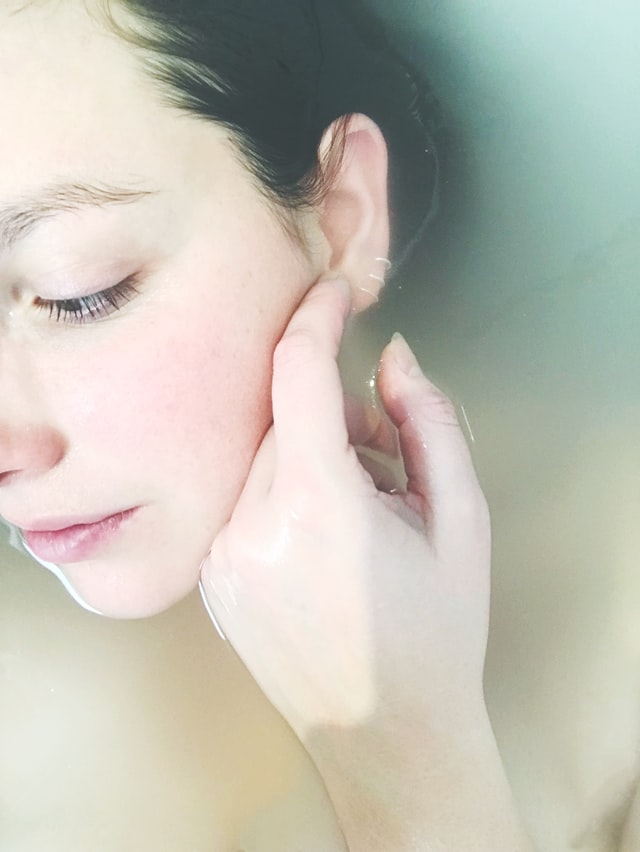To soothe sensitive skin rashes, try a cool compress. It reduces inflammation and numbs the area. You can also use cucumber slices; their water content cools and hydrates. An oatmeal bath or chamomile tea soak offers anti-inflammatory benefits and relaxation. Aloe vera gel is perfect for reducing redness, while a coconut oil massage locks in moisture. Consider honey mixed with turmeric for its antibacterial properties. These natural remedies can dramatically improve your skin’s condition. There are even more calming options waiting, ready to ease your discomfort and nurture your skin’s health. In addition to these soothing treatments, essential oils like tea tree or lavender can be effective for their antifungal and anti-inflammatory properties. For those looking for the best natural antifungal remedies for women, incorporating these oils into your skincare routine may provide added protection and relief. Always remember to do a patch test before applying new substances to sensitive areas to ensure compatibility with your skin.
Cool Compress Application
Applying a cool compress can provide immediate relief for sensitive skin rashes. When you feel discomfort from a rash, the cold temperature helps reduce inflammation and numb the area, easing itching and irritation. To make a compress, soak a clean cloth in cold water or wrap ice in a towel. Gently apply it to the affected area for about 10 to 15 minutes. Be cautious not to use ice directly on the skin, as it could cause frostbite or further irritation.
Before you start, make sure your skin is clean to avoid trapping any dirt or bacteria under the compress. You can repeat this process several times a day as needed. It's important to listen to your body—if the compress feels too cold or uncomfortable, remove it immediately.
After applying the compress, gently pat the skin dry with a soft towel. Avoid rubbing, as this can aggravate the rash. Following up with a gentle moisturizer can help lock in moisture and soothe the skin further. Remember, a cool compress is a simple, effective first step in managing sensitive skin rashes and can be easily incorporated into your skincare routine.
Oatmeal Bath Benefits
Taking an oatmeal bath can be a soothing remedy for sensitive skin rashes. You might not realize it, but oatmeal contains compounds that help calm inflammation and irritation. When you soak in an oatmeal bath, these compounds get released into the water, creating a silky, protective barrier on your skin. This barrier can help lock in moisture, ease itching, and reduce redness.
To prepare an oatmeal bath, you'll need colloidal oatmeal, which is finely ground to dissolve easily in water. Simply add about one cup of colloidal oatmeal to a lukewarm bath. It's important to avoid hot water, as it can further irritate sensitive skin. As you soak, you'll notice the water turning milky, which indicates the oatmeal is working its magic.
After your bath, gently pat your skin dry with a soft towel. Avoid rubbing, as this can aggravate your rash. You can use oatmeal baths as often as needed, especially during flare-ups. This simple, natural remedy can make a world of difference, bringing relief and comfort to your sensitive skin. Plus, it's a relaxing way to unwind after a long day.
Aloe Vera Gel Use

While oatmeal baths offer relief to sensitive skin, aloe vera gel provides another effective solution for soothing rashes. You've probably heard about aloe vera's skin benefits, but do you know how it works for rashes? This natural gel contains anti-inflammatory properties that help reduce redness and swelling, offering immediate comfort to irritated skin. Applying aloe vera gel is straightforward and doesn't take much time.
First, make sure the affected area is clean. You'll want to gently wash it with mild soap and water, then pat it dry. Once your skin is ready, apply a thin layer of aloe vera gel directly onto the rash. Make sure to use a pure gel for the best results, as additives might irritate sensitive skin further. You can either scoop the gel from an aloe vera leaf or use a store-bought product.
Leave the gel on your skin to absorb; you don't need to rinse it off. You'll notice it's light and non-greasy, which makes it comfortable to leave on throughout the day. Reapply as needed, especially if your skin feels dry or itchy again. Aloe vera gel not only soothes but also moisturizes, promoting healthier skin.
Chamomile Tea Soak
Steeping chamomile tea for a soothing soak can offer gentle relief for sensitive skin rashes. This method combines the anti-inflammatory properties of chamomile with the calming effect of a warm bath. To start, boil water and steep several chamomile tea bags for about ten minutes. Confirm the tea is highly concentrated for maximum benefits. Pour the steeped tea into your bathwater, mixing well to distribute the soothing agents evenly.
Once your bath is ready, immerse yourself in the warm, tea-infused water. Relax and let your skin absorb the natural compounds. Chamomile contains antioxidants like flavonoids and terpenoids, which can reduce redness and irritation. It's important to soak for at least 15 to 20 minutes to allow the tea to work its magic.
When you finish, gently pat your skin dry with a soft towel. Avoid rubbing, as this can aggravate sensitive areas. You'll likely notice a reduction in itchiness and discomfort. Chamomile's gentle nature makes it ideal for those with sensitive skin. Use this soak regularly for ongoing relief, but always do a patch test first to confirm no allergic reaction. Enjoy the soothing effects!
Coconut Oil Massage

Coconut oil can be your go-to remedy for soothing sensitive skin rashes. It's packed with natural antibacterial and anti-inflammatory properties, making it perfect for calming irritated skin. When you massage coconut oil onto a rash, it creates a protective barrier that locks in moisture and prevents further irritation. This is particularly beneficial if your rash is dry or flaky.
To start, warm a small amount of coconut oil in your hands. Gently massage it onto the affected area using circular motions. This not only helps the oil penetrate deeply but also improves blood circulation, promoting the skin's healing process. You'll notice that the oil absorbs quickly, leaving your skin feeling soft and nourished rather than greasy.
Be certain to use virgin, cold-pressed coconut oil for the best results. This type retains more nutrients beneficial for your skin. Apply the oil two to three times daily, especially after bathing, to see noticeable improvements. If you're consistent with this routine, you'll likely find that the redness and discomfort diminish over time. Remember, while coconut oil is generally safe, always do a patch test first to verify it doesn't cause further irritation.
Baking Soda Paste
Baking soda paste offers an effective, natural remedy for alleviating sensitive skin rashes. It's both simple to make and kind to your skin. To create the paste, mix one part baking soda with three parts water until you achieve a smooth consistency. This gentle mixture can help reduce itching and inflammation associated with rashes.
Once your paste is ready, apply a thin layer directly onto the affected area. You'll want to leave it on for about 10 to 15 minutes, allowing the baking soda to work its magic. It acts as a mild exfoliant, which helps to remove dead skin cells and reduce irritation. Afterward, rinse it off gently with lukewarm water and pat your skin dry with a soft towel.
Keep in mind that while baking soda is generally safe, it's crucial to do a patch test first. Apply a small amount to a less sensitive area of your skin to verify you don't have an adverse reaction. If any irritation occurs, discontinue use immediately. Using baking soda paste regularly can provide relief for sensitive skin rashes, helping to calm and soothe your skin naturally.
Honey and Turmeric

Honey and turmeric often provide a soothing combination for managing sensitive skin rashes. You might wonder why these ingredients work so well together. Honey is a natural humectant, meaning it helps retain moisture, keeping your skin hydrated and less prone to irritation. It also possesses antibacterial properties, which can help prevent infections in broken or inflamed skin.
Turmeric, on the other hand, is known for its anti-inflammatory and antioxidant properties. Curcumin, the active compound in turmeric, helps reduce redness and swelling, making it an excellent choice for calming irritated skin. When combined, honey and turmeric form a powerful duo that addresses both the symptoms and underlying causes of skin rashes.
To make a simple honey and turmeric mask, mix one tablespoon of raw honey with a teaspoon of turmeric powder. Apply the mixture to the affected area, allowing it to sit for about 15-20 minutes. Rinse off with lukewarm water and gently pat dry. You'll likely notice your skin feeling calmer and more nourished. Incorporate this remedy a few times a week to see improvements in your skin's condition. Remember, consistency is key to achieving the best results.
Cucumber Slice Relief
A few slices of cucumber can work wonders when it comes to soothing sensitive skin rashes. You might not realize it, but cucumbers are more than just a revitalizing salad ingredient. They're packed with water, vitamins, and minerals that help to cool and hydrate your irritated skin. When your skin feels inflamed and itchy, reach for a cucumber.
Start by washing a fresh cucumber thoroughly. Next, slice it into thin pieces. Make sure the slices are cool, as the cooling effect is part of what provides relief. Gently place the cucumber slices on the affected area. Leave them on for about 15-20 minutes. During this time, the cucumber's natural properties will work to reduce inflammation and redness, while the moisture helps to keep your skin hydrated.
If you want to enhance the soothing effect, you can chill the cucumber slices in the refrigerator before applying them. Once you've removed the slices, pat your skin dry with a soft towel. You'll likely notice your skin feels calmer and less irritated. This simple, natural remedy is a great way to give your sensitive skin the relief it needs.
Frequently Asked Questions
Can Sensitive Skin Rashes Be Caused by Stress?
Yes, stress can trigger sensitive skin rashes. When you're stressed, your body releases chemicals that may cause inflammation or worsen existing conditions. Managing stress through relaxation techniques can help reduce rash occurrences and improve overall skin health.
How Can I Prevent Sensitive Skin Rashes in the First Place?
An ounce of prevention is worth a pound of cure. Keep your skin clean and moisturized, avoid known irritants, and manage stress. Opt for gentle products and protect your skin from harsh weather to prevent rashes.
Are There Specific Dietary Changes That Help Reduce Skin Rashes?
You can reduce skin rashes by incorporating anti-inflammatory foods like fatty fish, leafy greens, and nuts into your diet. Avoid triggers like dairy or gluten if you're sensitive. Drinking plenty of water also helps maintain healthy skin.
How Long Should I Wait Before Consulting a Dermatologist for a Rash?
If your rash doesn't improve within a week or worsens, consult a dermatologist. Don't ignore severe symptoms like pain, fever, or blisters. Prompt attention helps in managing and diagnosing underlying issues effectively. Your skin's health matters.
Can Certain Fabrics or Clothing Materials Worsen Skin Rashes?
Did you know 30% of people experience worsened rashes due to synthetic fabrics? Avoid polyester or nylon, and instead, opt for natural fibers like cotton or bamboo. They'll help your skin breathe and reduce irritation effectively.
At a Glance
You've discovered a treasure trove of soothing solutions for those pesky sensitive skin rashes. As you embrace these remedies like a warm hug, remember that relief is just a cool compress or oatmeal bath away. Let aloe vera and chamomile tea be your gentle allies, while coconut oil and baking soda work their magic. Honey, turmeric, and cucumber slices complete your arsenal. With these natural treatments, you're ready to face any rash with confidence and comfort.






